Hang Loose Host
Makes Orchestrating DSP Plugins Dead Simple
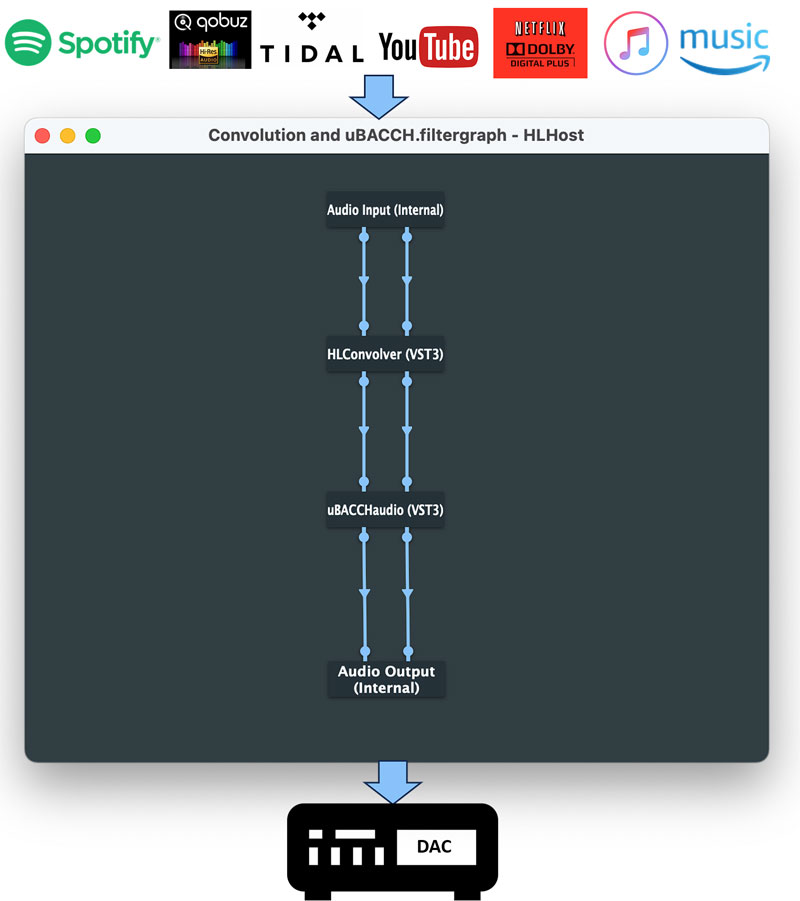
In the example above, HLHost is hosting two plugins, one a convolution plugin and one spatial plugin, wired in series. This is a common configuration that allows Digital Room Correction and immersive sound to be applied and enjoyed at the same time. HLHost includes audio input and output plugins.
Download the Latest Version 1.2.6
* Requires a license key for activation. See ops guide for version history.
Simple operation in 5 easy steps
- Scan for new or updated plugins.
- Add plugins to HLHost canvas.
- Wire up your plugins.
- Configure your input and output devices, sample rate and buffer size.
- Listen.
Hang Loose Host (HLHost) is a cross-platform application designed to host audio plugins, which can be added to the signal path to give you a multitude of DSP capabilities.
As an example, convolution plugins such as Hang Loose Convolver and Dirac Live Processor can add high resolution digital room correction (DRC) to your listening setup, or convolution for high resolution headphone filters.
Another example might be using uBACCH or X-Talk-Shaper cross talk cancellation plugins for spatial audio capabilities.
Looking for Active Room Treatment, try Room Shaper, or maybe you are into Auro-3D or DTS Neural Surround UpMix for immersive audio, or want to try an ultra-cool dynamic equalizer.
Thousands of plugins are available and can be easily inserted into your audio signal path and orchestrated using HLHost.
Features include:
- Windows 10 and 11. MacOS 10.15 or later, including Apple Silicon and Intel-based Mac computers. Ubuntu 20.04.5 LTS or later. Raspberry Pi 64-bit OS bullseye or later.
- Host any Audio Unit (AU), VST3, LADSPA, and LV2 plugin.
- 32 and 64-bit DSP processing depending on plugin capability.
- 64 channels of digital I/O.
- Simple Audio Settings dialog with input level meter. Select your digital I/O, sample rate, buffer size and go.
- Set and forget – once configured, save your filtergraph. Set to run at startup and Run Minimized.
- Complete flexibility in “wiring” plugins in any way for advanced usage scenarios.
- HLHost typically requires a 3rd party virtual audio loopback driver, such as Windows (VB-Cable, Virtual Audio Cable, VB-Matrix, LoopBeAudio), Mac (BlackHole), and Linux (ALSALoop), and including Raspberry Pi. Supports virtual audio drivers for Ravenna and Dante audio networks.
- Supports a variety of audio protocols: Windows: ASIO, WASAPI and Direct Sound. Mac: Core Audio, Linux: Pulse Audio, Jack, ALSA.
- Supports “hardware digital loopback” that is built-in to many “pro” audio interfaces.
- Automatic sample rate switching is supported (e.g. Qobuz->BlackHole) but varies across apps and platforms. Test your scenario.
Additional Info:
Easily add DSP “plugins” to your audio app
Examples of Simple Audio Settings Dialog
Windows
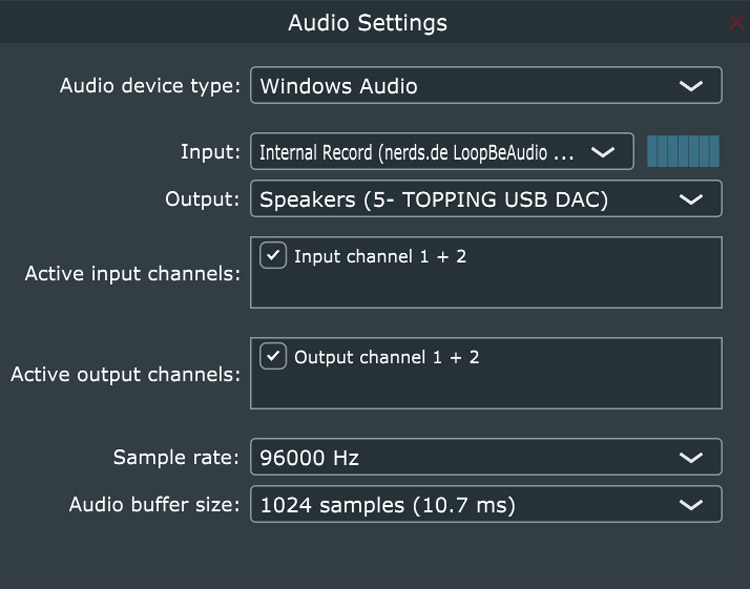
In this example, Windows Audio is selected, using the LoopBeAudio virtual audio loopback driver as input and a Topping USB DAC as output. Sample rate is set to 96 kHz with 1024 samples of audio buffer size.
Mac

In this example, BlackHole virtual audio loopback driver is selected as input and a Motu Ultralite mk5 DAC is the output. Note, this is configured for 16 channels of digital I/O. One can select/deselect any one of the active input or output channels as required.
Hardware Digital Audio Loopback
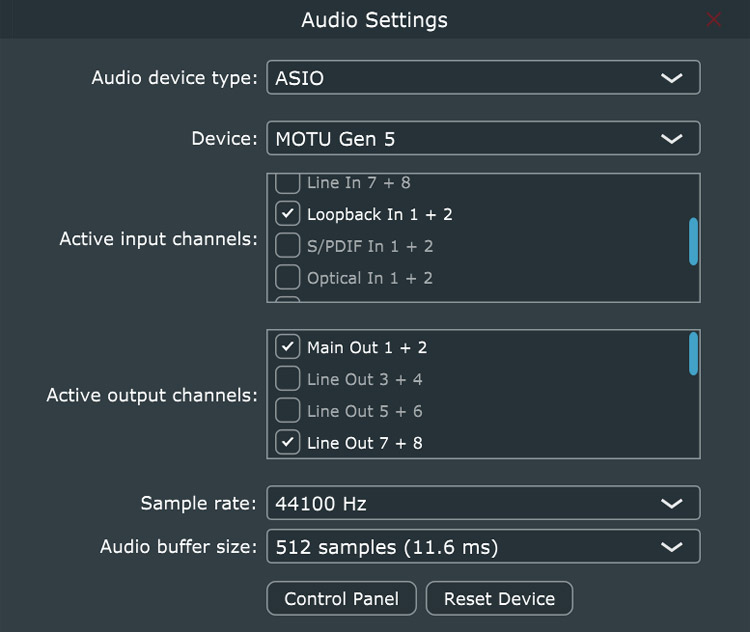
In this example, using ASIO on Windows, the music application or system wide audio is being output to channels 7 and 8 in Windows audio. In the Motu device, channels 7 and 8 are internally routed to loopback channels 1 and 2 which are input to HLHost. After DSP processing, the output is channel 1 and 2 Main Out. Check your audio interface to see if it supports h/w digital loopback.
Virtual Audio I/O to Ravenna network
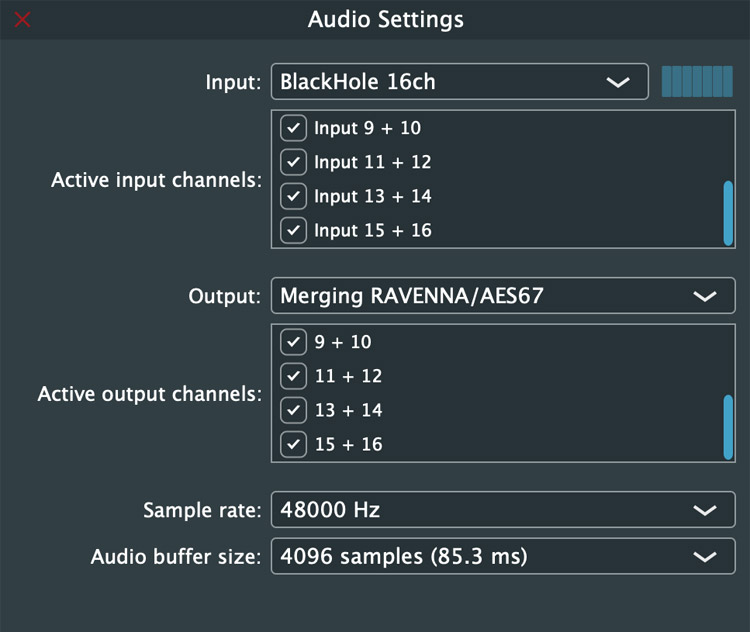
This example is using two virtual audio drivers. BlackHole 16 channels of input and 16 channels of Ravenna network audio output. For example, one can open the Mac OS TV app and play Dolby Atmos movies through HLConvolver for Digital Room Correction (DRC) with no lip sync issues.
Using Different Input/Output Audio Devices

In this example, HLHost is running under Windows. The input device is an ESI U24XL USB device that has S/PDIF digital input where an external CD player, SmartTV, or gaming console can be input the HLHost for DSP. The digital output is going to a different audio device, in this case a Topping E30 USB DAC.
Using the ESI U24XL as an example, it also has an Analog to Digital Converter (ADC) built in so analog sources like turntables and reel to reel players can be routed through DSP.
Advanced Plugin Configurations
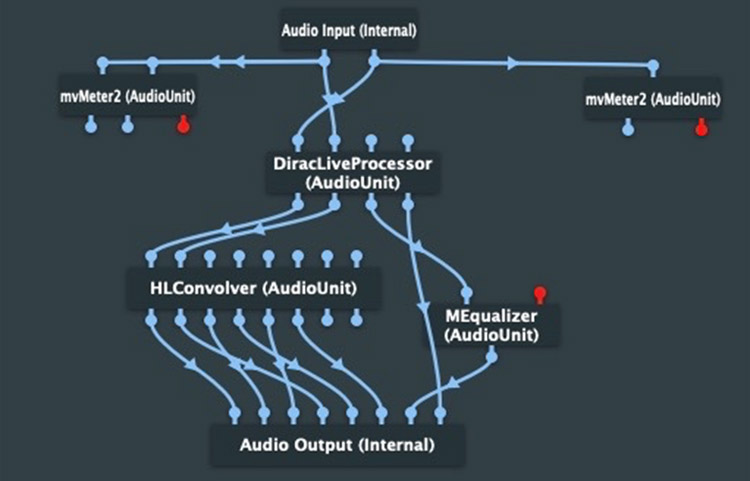
Here is an example of an advanced configuration. This is for a 4-way active stereo setup with two subwoofers:
mvMeter2 are used as VU meters to monitor the level of the stereo input. Dirac Live Bass Control is being used to apply digital room correction for two subs. Hang Loose Convolver is hosting the digital crossovers. And MEqualizer is being used to apply a high pass and low pass filter on one sub.
Given that any plugin can be added and wired up in any way, one has complete freedom to design any DSP processing scenario.


